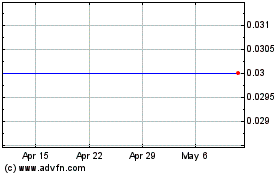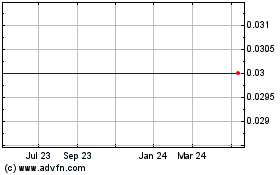Pancontinental Uranium Corporation (TSX VENTURE: PUC) ("Pancon" or
"the Company") and Crossland Uranium Mines Ltd. ("Crossland'), the
operator, are pleased to provide an update on progress with
exploration on their Chilling and Charley Creek Projects in the
Northern Territory, Australia.
Highlights:
- The program of air core drilling, announced October 1, 2009,
has been completed at the Buchanan Window at Chilling. The air core
drill program has tested many of the areas identified from
radiometric and geochemical sampling in 2009. The drilling
confirmed the previously postulated geological setting and provided
evidence for sub-surface continuity of outcropping zones enriched
in uranium and base metals. Results from sampling the oxidized zone
at Buchanan will be available in approximately five weeks.
- At the Cockroach Dam Prospect, Charley Creek Project,
follow-up of the radiometric anomalies with rock chip sampling has
produced strongly anomalous results, with a maximum value of
4,550ppmU, and an arithmetic average of all 186 outcrop samples
collected to date at Cockroach Dam of 373ppmU or 439ppm U3O8.
- A diamond drill is currently operating at March Fly, at the
northern end of the Chilling Project, and an intensive field
program is under way in the MEMA/Fletchers Gully area of the
Chilling Project to prepare the area for 2010 exploration ahead of
the pending onset of the wet season.
CHILLING PROJECT
Buchanan Window
At the Chilling Project, an air core drilling program totalling
87 holes for 2,586m has recently concluded in the Buchanan Window,
an area of approximately 35 square kilometres containing
lithologies of the lowermost stratigraphy in the Pine Creek Orogen.
These lowermost sediments hold almost all of the past uranium
producing deposits of the region, at Rum Jungle and The Alligator
Rivers Region, as well as most quantified unmined resources.
The air core holes provided useful information on the weathered
profile throughout the area, with an average depth of around 30m,
and a maximum depth of 75m. The holes have been probed and the
probe results and geology encountered in the holes have been used
to select samples that have been submitted for analysis. The air
core holes could not penetrate to fresh bedrock due to a
combination of deep weathering and heavy ground water flows. This
means that all samples are of oxidized material, where leaching of
values of uranium and base metals has occurred. The 2009 drilling
provided sufficient data to confirm the geological setting that was
previously postulated, as well as evidence for sub-surface
continuity of outcropping zones enriched in uranium and base
metals. It will be necessary to obtain samples of unweathered
bedrock to encounter primary grades of mineralization, which will
be the primary focus of the exploration and drilling program at
Buchanan in 2010. Assay results should be available before the
Christmas break.
March Fly
A diamond core drilling program of up to four holes has
commenced at March Fly, also in Chilling, to follow up on open
zones of uranium mineralization revealed from interpretation of
drilling in 2008. As well, field work is continuing in the MEMA and
Fletchers Gully areas, including an area containing outcropping
secondary uranium mineralization that may be associated with
structures revealed by the Airborne EM survey, completed in
conjunction with Geoscience Australia in September 2009. This
program consists of detailed ground radiometric surveys and soil
geochemistry. It will continue until the work is curtailed by the
Northern Territory's annual wet season.
CHARLEY CREEK PROJECT
Field work has continued at the Charley Creek Project, near
Alice Springs, continuously since January of this year. The work
has been focused on a detailed spectrometer survey of some 42
square kilometres of the highly radioactive Teapot Granite at the
Cockroach Dam Prospect on Narwietooma Cattle Station. This major
survey is now nearing completion with many anomalous zones
indicated over the year's work.
In August, the follow up of these results began with the
collection of an additional 148 rock chip samples to supplement the
38 rock chip samples reported in August 2008 from Cockroach Dam.
The distribution and uranium content of these samples is
illustrated in the accompanying figure (see figure one). Over 80%
of these samples exceed 32ppmU, a threshold value for geochemical
anomalies in the region. Six of the outcrop samples now have
returned values of over 2,000ppmU, with a maximum value of
4,550ppmU (5,364ppm U3O8). These values are supported by a strong
spread of other elevated results, with a total of 15 samples
exceeding 1,000ppmU, 47 exceeding 500ppmU, and 111 exceeding
100ppmU, which represents around 60% of the total sample
population. The arithmetic average of all 186 rock chip samples is
373ppmU, or 439ppm U3O8.
Crossland's Exploration Director, Geoff Eupene, said: "We
believe we have identified another large and significant uranium
system in the Cockroach Dam Prospect. The anomalies recently
followed up to obtain these results were those that were identified
from the first 60% of the spectrometer survey; we believe that many
additional areas of interest will emerge from the next 40% of the
survey, still to be completed."
"A clustering of the higher values is evident in the results and
in the field, and it is apparent that there is continuity in some
of these zones. This is a very important observation, because if
there is continuity in the surface plane, then we can expect
continuity in the depth dimension as well. If this continuity can
be proven it should enable us to build a resource quickly, once
drilling commences," Mr. Eupene said.
Click here to view photo:
http://media3.marketwire.com/docs/PUC1111.gif
"Technically, we are ready to start drill testing at Cockroach
Dam, once we receive the necessary permits."
Once the detailed spectrometer survey is completed, Crossland
will analyze the data and continue the follow up program referenced
above. Additionally, Crossland proposes to experiment with even
closer spaced spectrometer surveys over the prospective areas
identified from the current survey. As well, Crossland and its
indigenous advisers will continue to engage with local communities
to increase their understanding of uranium exploration and
mining.
All technical information in this release has been reviewed by
Geoff Eupene, Qualified Person for Crossland and Pancon.
About Pancontinental Uranium Corporation
Pancontinental Uranium Corporation ("Pancon") is a
Canadian-based company focused on uranium discovery and
development. Through a joint venture with Crossland Uranium Mines
Limited ("Crossland") of Australia, Pancon has established one of
the strongest management teams in the uranium industry. This
management and operating team has unparalleled experience from
exploration, through development to operations, and includes people
who were instrumental in the discovery of two of the largest
uranium deposits in the world. Pancon holds an impressive
exploration portfolio with projects in prolific, mining friendly
districts. Active exploration is ongoing at four Australian
projects which include Chilling, Charley Creek, Kalabity and
Crossland Creek. The Chilling project has the potential to host a
mirror image of a portion of the renowned Alligator Rivers Uranium
Field containing the large Jabiluka, Ranger and Koongarra deposits.
Pancon is earning a 50% interest in this significant uranium
project portfolio through the joint venture with Crossland through
the expenditure of A$8 million. Pancon and Crossland are also
pursuing exploration beyond Australia through an international
subsidiary company, Crosscontinental Uranium Limited, and immediate
plans include formulating an exploration program in Burkina
Faso.
ON BEHALF OF THE BOARD OF DIRECTORS
Rick Mark, President & CEO
Cautionary Language and Forward Looking Statements
This press release may contain "forward-looking statements",
which are subject to various risks and uncertainties that could
cause actual results and future events to differ materially from
those expressed or implied by such statements. Investors are
cautioned that such statements are not guarantees of future
performance and results. Risks and uncertainties about the
Company's business are more fully discussed in the Company's
disclosure documents filed from time to time with the Canadian
securities authorities.
Neither TSX Venture Exchange nor its Regulation Services
Provider (as that term is defined in the policies of the TSX
Venture Exchange) accepts responsibility for the adequacy or
accuracy of this release.
Contacts: Pancontinental Uranium Corporation Richard Mark
President and CEO 604-986-2020 or 1-866-816-0118 Pancontinental
Uranium Corporation Keith Patey Director of Communications
604-986-2020 or 1-866-816-0118 604-986-2021 (FAX)
www.PanconU.com
Pancontinental Resources (TSXV:PUC)
Historical Stock Chart
From Jan 2025 to Feb 2025

Pancontinental Resources (TSXV:PUC)
Historical Stock Chart
From Feb 2024 to Feb 2025
